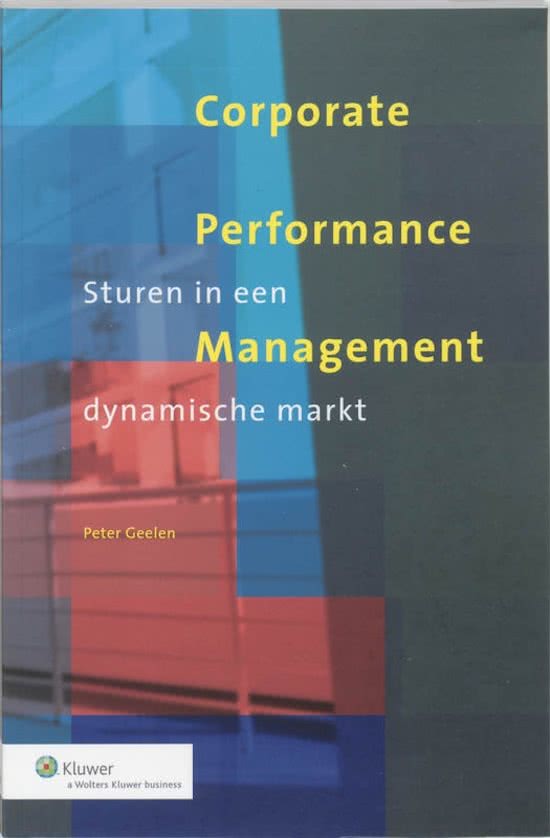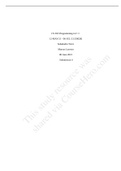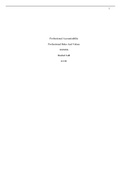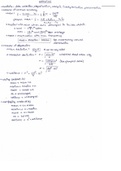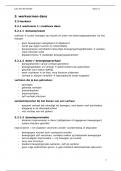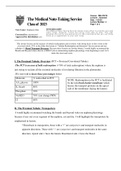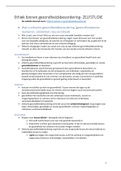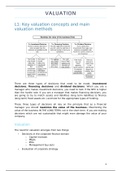Workbook 1 – Performance management in context.
1. Explain how the focus shifed from performance assessment to an integrated approach to
performance management.
Performance assessment has a long history based on comparatie judgements of human worth.
Modern performance assessment deieloped from sophistcated ratng systems designed by work
psychologists for military use during the two world wars. Performance assessment was initally used
for promotons; salary increases, and discipline (Price 2011:402). Fletcher and Williams (1992:-8))
proiide an oieriiew of the deielopment of performance management.
They trace the origins of performance management as far back as the First World War, focusing on
the period since the 19-0s, a decade that iniolied personality8based appraisal. The focus then was
on eialuatng performance, but with no intension of improiing it
19-0’s 8 personality8based appraisal
1960’s 8 goal setng and assessment of performance related abilites (competencies)
19)0’s 8 and whole of 1990’s rapid and successiie change
8 Fletcher performance appraisals = central mechanism and more holistc approach to managing
people and business manager does work by getng people to do theirs. More performance
orientated. More core management process
2. Identify the main elements of performance management.
Is a contnuous, formal and structured process;
Aligns performance with the strategic goals of the organisaton; and
Eialuates and deielops employees’ job8related attudes, behaiiours and performance.
3. Define performance management
Performance management is a fundamental part of the rest of the enterprise and something recognised
as contributng to the achieiement of the strategic goals of the organisaton.
Performance management is a continuous process of identfying, measuring and deieloping the per8
formance of indiiiduals and teams and aligning performance with the strategic goals of the organisa8
ton.
Two main components:
Continuous Process – Performance management is on-going. It iniolies a neier8ending process of set-
ting goals and objecties, observing performance and receiiing on8going coaching & feedback.
Alignment with Strategic Goals – Performance management requires managers to ensure that employ-
ees’ activities and output are congruent with the organisation’s goals and consequently help the organ8
isaton gain competitive advantage.
Performance therefore creates a direct link between employee performance and organisatonal goals and
makes the employee’s contribution to the organisation explicit.
,4. Explain how performance management fits into an integrated human resource management
(HRM) system.
Performance management actiites should be aligned with the organisaton’s internal
eniironment, the external eniironment and other HR actiites. The internal eniironment refers to
the organisaton’s business strategy, the company culture and technology. The external
eniironment includes laws and regulatons, the labour market and the country culture. Other HR
actiites refer to performance8based incenties and employee deielopment.
Internal Environment
Three key issues in the internal eniironment, namely:
- Organisatons business strategy
- Company culture
- technology
Performance management actiites can only be efectie if they are aligned with the organisaton’s
business strategy and the company culture in the internal eniironment. Managers should translate
the objecties of the organisaton’s business strategy into specifc behaiiours and goals for their
employees.
When a company’s culture depends on efectie performance management, it can be described as
a performance8driien culture. Companies with performance8driien cultures share a common focus
on monitoring and improiing performance.
Technology also plays an increasingly important role in performance8driien cultures by making it
possible for employees to receiie detailed informaton about their behaiiour and performance,
which can then be used in their performance deielopment.
External Environment
Three key issues in the external eniironment infuence performance management, namely:
- the legal eniironment,
- the labour market and
- the country culture.
The laws and regulatons in the legal eniironment serie as the basic principles to ensure the
legality of performance management practces. These laws and regulatons protect employees
against negatie consequences in the workplace caused by unfair discriminaton and the use of
inappropriate informaton when making employment decisions
The labour market refers to the geographical area from which employers recruit their employees
for partcular jobs.
Diferent country cultures result in diferent HR practces and how employees relate to the work
eniironment. Performance management does not occur in a iacuum, but through interpersonal
interactons.
5. Clarify how performance management relates to other human resource (HR) activities.
Demonstrate how performance management is integrated with other HR activities.
, Being central in an integrated HRM system, performance management actiites should also be
aligned with other HR actiites in the organisaton. The use of job analysis is required in the
deielopment of fair and legally sound performance measures.
Performance measurement proiides ialuable informaton for use in strategic planning and
organisatonal change, recruitng and retaining of employees, as well as performance8based pay.
Performance management can reieal defciencies that suggest the need for additonal training and
deielopment.
Alignment with other HR actiites also implies inioliement and buy8in from eieryone afected by
performance management.
6. Distinguish between performance management; performance appraisal and performance
feedback.
A comparison between performance appraisal and performance management
The diferences between performance appraisal and performance management
Performance appraisal system Performance management system
Focus Focus is on performance appraisal
and generaton of ratngs Focus is on performance management
Emphasis Emphasis is on relatie eialu8 Emphasis is on performance improie8
aton of indiiiduals ments of indiiidual and his or her depart8
Emphasis is on ratngs and eialu8 mental or team performance
aton. Emphasis is on performance planning,
analysis, reiiew, deielopment and im8
proiements
Timing Annual exercise – though normally Contnuous process with quarterly or
periodic eialuatons are made periodic or performance reiiew discussions
Rewards Rewards and recogniton of good Performance rewarding may or may not be
performance are an important an integral part – defning and setng
component performance standards are an integral part
Design & Designed and monitored by the HR Designed by the HR department but could
monitoring department be monitored by the respectie
departments themselies
Ownership Ownership is mostly with Ownership is with line managers;
HR/administraton HR/administraton facilitates its
implementaton
KPA Key performance areas (KPAs) and KPAs or KRAs are used as a planning
key result areas (KRAs) are used for mechanism
bringing in objectiity
Review There are reiiew mechanisms to There are reiiew mechanisms essentally to
ensure objectiity in ratngs bring performance improiements
System It is a system with deadlines, It is a system with deadlines, meetngs,
meetngs, input and output, and a input, output and a format
format
Driver It is format8driien with the emphasis It is process8driien with the emphasis on
on the process linked to promotons, the format at aid linked to performance
rewards, training and deielopment improiements and through them to other
interientons, placements etc. career decisions as and when necessary.
, The key diference between performance feedback and performance appraisal
Criteria Performance feedback Performance appraisal
Time period Past, present and future Past
Focus Links employee actiites to specifc Creates records; documents performance
business objecties and strategy problems
Nature of Two8way One sided, downwards, directie, rebuual
communicaton sometmes allowed.
Role of Actie partcipant Passiie
employee
Formality Informal, ierbal High formality, wriuen forms with
signatures
Timing Spontaneous, ad hoc as needed As prescribed (usually annually)
Basis of Collegiality Power
relatonship
Role of Coach, motiator, partner Authority fgure
superiisor
Outcomes Partcipaton; enhanced and Compensaton decision; task directies
targeted performance; improied
relatonships
7. What are the objectives of performance appraisal system?
The main objecties of a performance appraisal system are:
To increases the employee efectieness by helping them understands their role beuer.
To help the employees understand their strengths and weakness in the current role.
To help the managers in identfying the training needs of their sub8ordinates.
To improie the relatonship between the line manager and his team members by making them
realize that they are dependent on each other for beuer performance.
To help the line mangers and their team members in improiing the communicaton by discussing
the problem in achieiing the targets and fnding the potental solutons.
To proiide the employee an opportunity for self8eialuaton and self8deielopment which are
important to achieie the goals.
To prepare the employees for higher roles.
To create a positie work atmosphere.
To collect the informaton about each employee through personal meetng this is useful in making
managerial decisions.
8. Why do performance appraisal systems fail?

